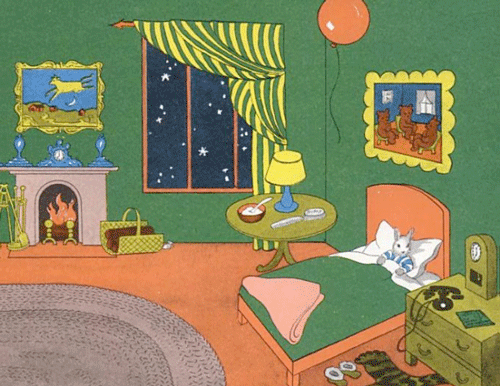My Book Club – quirky critical takes on children’s literature. Otherwise known as what happens when someone interested pop culture analysis has read the same bedtime story for the 100th time.
As anyone who has met a toddler knows, they have a very different, warped perspective on the world, at least in comparison to adults. Which is why absurdism is such a perfect match for them. So it makes sense that Goodnight Moon is a beloved favorite of that age group – it’s a master class in absurdism in only a few hundred words.
Wikipedia actually provides a surprisingly good, concise definition of absurdism: “Absurdism focuses on the experiences of characters in a situation where they cannot find any inherent purpose in life, most often represented by ultimately meaningless actions and events that call into question certainties such as truth or value.” Common elements include dark humor, nonsensical elements, irrationality, and situations that have little or no meaning. They generally have no moral conclusion and make no judgment on the character’s actions.
Goodnight Moon has many of these elements in abundance. There are hardly any characters, much less those who have an inherent purpose. The little bunny and “old lady whispering hush” appear to be the only things with any decision making ability, and even as they gradually change positions, there’s no clear explanation as to why. The best guess that can be made is that the little bunny is the nameless narrator, saying goodnight to all of the things in his room before going to sleep. As anyone who has ever tried to put a toddler to bed knows, this process will certainly bring certainties of truth, value and sanity into question.
The absurdity is further heightened by the number of times the narrator says goodnight and what they are saying goodnight to. More than half of the book consists of the narrator saying goodnight to some object or another. While a child saying goodnight to stuffed animals and perhaps the moon makes sense, saying goodnight to “nothing,” “air,” and “noises everywhere” indicates either a disturbing personification of ubiquitous objects or an endless echo of goodbyes that have no endpoint. Either is enough to force a grown adult to confront the irrationality of living with a small child in the first place.
The narrative further serves to disorient the reader and warp their perception of reality by having a slightly shifting visual perspective. At first, it appears that the book switches back and forth between showing the bunny’s bedroom and highlighting various objects in the bedroom, from a picture of the three bears to “a comb and a brush and a bowl full of mush.” However, the bedroom setting changes slightly over time, showing the old lady saying “hush” there and then randomly not, the room getting dark, and the little bunny (finally) settling down to sleep. In addition to the changes over time, there are also slight changes in the framing of space. The frame of the page subtly zooms in and out of the room, creating an unsettling effect where you aren’t quite sure if what you are seeing is what you saw before. The pages that highlight objects often leave out key details that are in the larger picture. For example, the page focused on the mittens shows only the mittens on the drying rack, even though the larger picture shows the socks also on the rack. The Ugly Volvo hilariously deconstructs all of the other disturbing elements of the “great green room.”
Goodnight Moon even shows hints of postmodernism. As Jed at My Little Po-Mo says (yes, it is a critical analysis blog focused on My Little Pony): “Most of the time, we are unaware of the constructs that shape our reality, so postmodern works try to draw attention to the constructs in play, usually by subverting them.” Goodnight Moon touches on the construct of “what a classic piece of children’s literature is.” It does so by explicitly referring to three different children’s stories in the text and pictures. The first, the “three little bears sitting on chairs,” obviously refers to Goldilocks and the Three Bears, a story that most children in English speaking countries know. The second is the picture on the wall of a mother bunny “fishing” for a baby bunny. Unlike almost all of the other decorations, this is not called out in the text and may not be something that many readers recognize. It is actually a picture from a different book by the same Writer/Artist team, The Runaway Bunny. The third reference is to Goodnight Moon itself, a copy of which is tucked away on the nightstand. These last two references are in clear comparison to the first, suggesting that the authors’ own works are comparable to Goldilocks. As Goodnight Moon has sold millions of copies, it certainly seems like their textual playfulness was prescient.
What makes Goodnight Moon brilliant is it’s use of absurdism to illustrate the toddler mindset. While the book can baffle parents, the utter ridiculousness of the repetition and overall approach seems perfectly normal to them. After all, they’re used to falling asleep in one place and waking up in another, an experience that would be terrifying for an ordinary adult. The world in general is radically weird for little ones; Goodnight Moon helps us enter their very strange perspective for just a little while.

Pingback: This week in the Slacktiverse, February 8th, 2015 | The Slacktiverse
Pingback: Visiting the Park with a Toddler and Newborn: A Play in 3 Acts - We'll Eat You Up - We Love You So